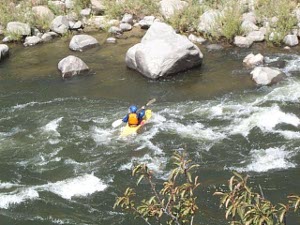This tall thin state has a wonderful range of scenery, from mountains and canyons and blue trout streams in the north to irrigated farmland and lava beds  A river kayaker
in the south. Driving along the Lolo and Snake Rivers, we saw real white water, thick and foamy, and in the gentler patches people in kayaks, catamarans, inner tubes, inflatable rafts and flat-bottomed fishing boats enjoying the summer sun.
A river kayaker
in the south. Driving along the Lolo and Snake Rivers, we saw real white water, thick and foamy, and in the gentler patches people in kayaks, catamarans, inner tubes, inflatable rafts and flat-bottomed fishing boats enjoying the summer sun.
Our AAA guidebook told us the population of Boise was 125,000, but the sign on the edge of town says 185,000. With all the new construction we saw, that number must still be growing, with lots of spread to the surrounding suburbs. Boise is a busy, prosperous-looking place. Those we asked can't explain the sudden and continued growth, except that "lots of people are moving here from California."
We had the special pleasure of making a rendezvous with some Ridgecrest friends who were also visiting the area. We spent a day with Larry and Marcia, including a visit to a Birds of Prey refuge along the Snake River. Although we didn't see any eagles or ospreys (wrong time of year) we saw enough  Birds of Prey Refuge
guano to convince us the place is popular in the early spring. The view itself is well worth the drive from Boise - out a long gravel road past ranches and farms, through a somewhat featureless desert until we reached the edge of the canyon and looked almost straight down to the Snake River, which appeared to flow gently.
Birds of Prey Refuge
guano to convince us the place is popular in the early spring. The view itself is well worth the drive from Boise - out a long gravel road past ranches and farms, through a somewhat featureless desert until we reached the edge of the canyon and looked almost straight down to the Snake River, which appeared to flow gently.
We finally saw some potato fields, and we have to agree that the local potatoes are quite tasty. "Famous Potatoes" is the slogan on the Idaho license plates.
Boise boasts several State museums which are clustered near the University, in a lovely park which comes complete with rose garden.
The Idaho State History museum is supported by the state historical society, whose members continue to rustle up new contributions for the museum. The rich variety of artifacts is accompanied by good displays and story boards which tell a pretty complete story of the state.
We were particularly impressed with two facets of this museum: the inclusion of information about the many different cultures comprising the state,  Idaho state capitol
with candid explanations of the difficulties confronted in melding them together (including early miners' union battles); secondly, the presence of a reconstructed Victorian parlor and partial facades of other buildings which were saved when the buildings themselves were demolished. Because of the geography, there was less cattle ranching and more mining and lumbering in Idaho than Montana. Over half the miners were Chinese, hoping to make their fortune and return to China. Does anyone know what percentage did return? The mining conditions were abysmal, and led to some early union movements and strikes.
Idaho state capitol
with candid explanations of the difficulties confronted in melding them together (including early miners' union battles); secondly, the presence of a reconstructed Victorian parlor and partial facades of other buildings which were saved when the buildings themselves were demolished. Because of the geography, there was less cattle ranching and more mining and lumbering in Idaho than Montana. Over half the miners were Chinese, hoping to make their fortune and return to China. Does anyone know what percentage did return? The mining conditions were abysmal, and led to some early union movements and strikes.
The Art museum is small but its collection is varied. Our favorite was a traveling exhibit from the Portland, Oregon, Art Museum. We enjoyed a family also visiting, with grandma "explaining" some of the art to her five-or-six-year-old grandson (who we think had his own opinions.)
We had to pick up some mail in Salt Lake City, or else we might have lingered longer in Idaho; but we always save lots to see on our next visit.
 A river kayaker
in the south. Driving along the Lolo and Snake Rivers, we saw real white water, thick and foamy, and in the gentler patches people in kayaks, catamarans, inner tubes, inflatable rafts and flat-bottomed fishing boats enjoying the summer sun.
A river kayaker
in the south. Driving along the Lolo and Snake Rivers, we saw real white water, thick and foamy, and in the gentler patches people in kayaks, catamarans, inner tubes, inflatable rafts and flat-bottomed fishing boats enjoying the summer sun.
 Birds of Prey Refuge
Birds of Prey Refuge Idaho state capitol
Idaho state capitol